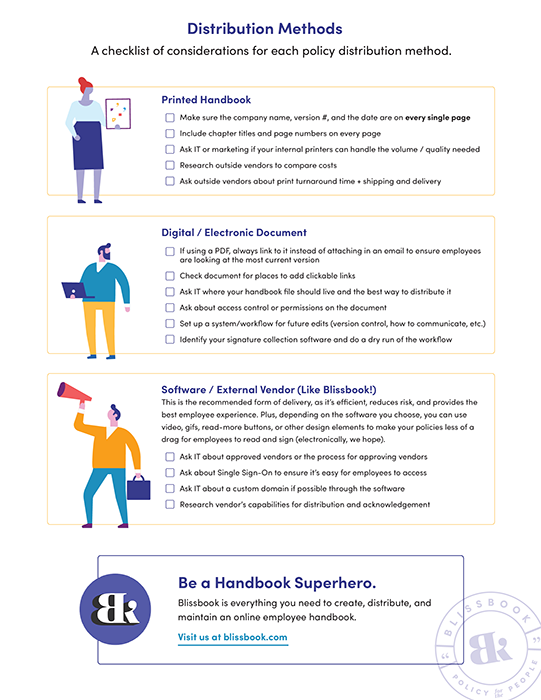How to Write Policies & Procedures
6: The Accept Work
Distribution and Sign Off

I always tell my clients more communication is better. You want to make sure that your workforce always understands what’s going on, which is probably the biggest reason you need policies and procedures in a handbook. Plus, they are a way to communicate to employees what you really believe in.
Once your handbook is ready for distribution (woohoo!), it’s time to set it up for the best possible reception. You may want to solicit your communications or marketing team again to help build your communication plan. Your approach will be driven by how drastically the company policies have changed from the previous version.
Consider the Following Situations:
Your policies have remained the same with only minimal changes, but you wanted to create a handbook more aligned with your company brand.
Great! Since there isn’t anything that’s likely to upset employees, you can send out an invitation to a company town hall or add an agenda item to a standing town hall and make the announcement to lots of cheers and praise.
Your policies have remained the same, but some procedures have changed, which may cause confusion for some or all employees.
If confusion is to be experienced only by a specific group of people, consider starting with a town hall announcement, but offer a follow-up discussion for the groups most significantly impacted. Send invitations to discuss the changes more thoroughly with those people, then provide an email recap to all individuals, including a link to the recorded discussion for those unable to attend.
Some policies have changed, and those changes may distress employees.
This is where the old adage, “tell them what you’re going to tell them, tell them, then tell them what you told them,” comes into play. Start with the invitation to the town hall with mandatory attendance. Then, during the town hall, first convey why changes were necessary before explaining the extent of the changes. Then, communicate how employees may be affected and when. Invite employees to discuss the changes with their managers or the hr team and provide an opportunity for a follow-up discussion if needed.
Afterward, send an email recapping the discussion, providing the handbook for their review, and directing them to the specific area that covers the change. Don’t forget to remind them of the why again to increase their willingness to understand the need for change.
Case Study: handling an unpopular revision
Cynthia knew that the revision to the company bonus policy might be unpopular. To ensure employees understood the reason behind the change and what it would mean to each one, her team provided a communication strategy that coincided with benefits enrollment, conducted multiple webinars with the opportunity for employees to ask questions, and sent out a reminder before the change would be visible in their next paycheck. They were transparent through the whole process, which reflected a key company value and was appreciated by the employees.

Cynthia Gore
Head of HR Operations and Talent Acquisition at Mercedes-Benz USA

Employee Acknowledgements
When it comes to collecting sign offs on the handbook, you’ll want to provide enough time for employees to review, ask questions, and offer suggestions for improvements. It has taken a lot of time and effort to get to this point, so it’s natural to want to close this last part of the project ASAP and move on to all the other projects demanding your attention. However, reading and signing the handbook is not likely to be on the top of your employees’ priority list (no matter how awesome you made it), so you’ll want to provide a reasonable window of time. Thirty days is a common threshold for allowing employees to read, ask questions, and agree.
If you’re distributing a print version of the handbook and physically collecting signatures, you may need to rely on team managers to ensure that their employees respond in a timely manner.
If possible, use electronic signatures; it’s easier for everyone. With an electronic version of the handbook, employees can quickly locate information they need and reference it later. Plus, they have a version they can easily review when a situation arises. Adherence to policies and procedures is key, so it won’t help anyone if employees can’t find the handbook six months down the road or if the version they do find is outdated.
Your company will be better protected if employees have an always-accessible electronic handbook that maintains records of employee acknowledgements. Embrace technology and make your life easier.


